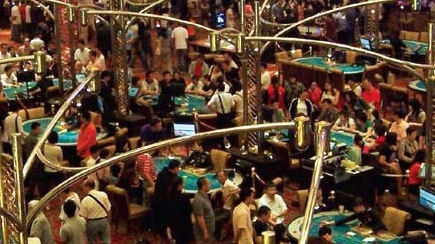This article first appeared in the Sep/Oct 2010 issue of World Gaming magazine.
Baccarat is the king of casino games in Macau. A staggering 88 percent of Macau casino action is baccarat, with all the other games combined accounting for only 12 percent. And the other games have been growing!
Three quarters of all baccarat action is VIP baccarat, with only a quarter being mass gaming. This led one senior casino executive to quip at the recent G2E Asia gaming conference, “actually VIP baccarat is the mass baccarat game in Macau”.

With this fixation on the game James Bond likes to play, it’s no surprise that there are almost as many baccarat systems as there are players. Some systems, such as “ping pong” and “follow the dragon”, are more famous than others. Maths forms the basis of some parts of some of these systems, and of course forms no part of others! We’ll have more to say about the various different types of baccarat systems in a later issue of World Gaming.
Casino players are fascinated by numbers and statistics, so we here at World Gaming decided to delve a little deeper into the maths of this most famous game. This isn’t an exercise in telling you how to beat baccarat, but just giving you some facts and figures to deepen your knowledge of the game.
Starting hands and naturals
Of course we ignore the suits in baccarat, so there are 13 possible cards in the deck: 1 (the ace), 2, 3, 4, 5, 6, 7, 8, 9 and the four 0s (10, jack, queen and king). Whenever a card is drawn from the shoe, there is a 1/13th chance of it being a 1, 2, 3, 4, 5, 6, 7, 8 or 9, and a 4/13ths chance of it being a 0 (we are ignoring the minute changes that result from card removal for now). Because of the 13 denominations, the initial two-card hand of either the banker or player has 169 combinations. 25 of those 169 combinations result in a starting hand of zero (also known as baccarat). Each of the other totals possible (1, 2, 3, 4, 5, 6, 7, 8 and 9) has precisely 16 combinations. So they are all equally likely (see the table).
|
TWO CARD COMBINATIONS
|
||||||||||||||||
|---|---|---|---|---|---|---|---|---|---|---|---|---|---|---|---|---|
|
1st card
|
||||||||||||||||
|
2nd card
|
0
|
0
|
0
|
0
|
1
|
2
|
3
|
4
|
5
|
6
|
7
|
8
|
9
|
|||
|
0
|
0
|
0
|
0
|
0
|
1
|
2
|
3
|
4
|
5
|
6
|
7
|
8
|
9
|
|||
|
0
|
0
|
0
|
0
|
0
|
1
|
2
|
3
|
4
|
5
|
6
|
7
|
8
|
9
|
|||
|
0
|
0
|
0
|
0
|
0
|
1
|
2
|
3
|
4
|
5
|
6
|
7
|
8
|
9
|
|||
|
0
|
0
|
0
|
0
|
0
|
1
|
2
|
3
|
4
|
5
|
6
|
7
|
8
|
9
|
|||
|
1
|
1
|
1
|
1
|
1
|
2
|
3
|
4
|
5
|
6
|
7
|
8
|
9
|
0
|
|||
|
2
|
2
|
2
|
2
|
2
|
3
|
4
|
5
|
6
|
7
|
8
|
9
|
0
|
1
|
|||
|
3
|
3
|
3
|
3
|
3
|
4
|
5
|
6
|
7
|
8
|
9
|
0
|
1
|
2
|
|||
|
4
|
4
|
4
|
4
|
4
|
5
|
6
|
7
|
8
|
9
|
0
|
1
|
2
|
3
|
|||
|
5
|
5
|
5
|
5
|
5
|
6
|
7
|
8
|
9
|
0
|
1
|
2
|
3
|
4
|
|||
|
6
|
6
|
6
|
6
|
6
|
7
|
8
|
9
|
0
|
1
|
2
|
3
|
4
|
5
|
|||
|
7
|
7
|
7
|
7
|
7
|
8
|
9
|
0
|
1
|
2
|
3
|
4
|
5
|
6
|
|||
|
8
|
8
|
8
|
8
|
8
|
9
|
0
|
1
|
2
|
3
|
4
|
5
|
6
|
7
|
|||
|
9
|
9
|
9
|
9
|
9
|
0
|
1
|
2
|
3
|
4
|
5
|
6
|
7
|
8
|
|||
|
Total
|
Combinations
|
Chance
|
|---|---|---|
|
0
|
25
|
14.8%
|
|
1
|
16
|
9.5%
|
|
2
|
16
|
9.5%
|
|
3
|
16
|
9.5%
|
|
4
|
16
|
9.5%
|
|
5
|
16
|
9.5%
|
|
6
|
16
|
9.5%
|
|
7
|
16
|
9.5%
|
|
8
|
16
|
9.5%
|
|
9
|
16
|
9.5%
|
|
169
|
100%
|
Notice also these chances for your first two cards:
|
Chance of getting any natural (8 or 9) and winning
|
16.25%
|
|
Chance of getting any natural (8 or 9) and pushing
|
1.79%
|
|
Chance of getting a natural 8 and losing to natural 9
|
0.90%
|
|
Chance of not getting a natural and losing to a natural
|
15.35%
|
|
Chance of neither side getting a natural
|
65.72%
|
|
100.00%
|
So you can notice that about 1/3rd of the hands are decided by natural (that is, either banker or player or both get an 8 or 9), and about 2/3rds of the hands continue on with neither side getting a natural 8 or 9.
Non-natural four card hands
So what if neither side gets a natural? Well if both the player and the dealer have 6 or 7, no more cards are drawn. Here are the chances:
|
Player
|
Banker
|
Winner
|
Chance
|
|---|---|---|---|
|
7
|
7
|
Tie
|
0.90%
|
|
7
|
6
|
Player
|
0.90%
|
|
6
|
7
|
Banker
|
0.90%
|
|
6
|
6
|
Tie
|
0.90%
|
|
3.59%
|
Given that the chance of either side having a natural is 34.28%, and the chance of a non-natural four card hand (both sides have 6s or 7s) is 3.59%, we can conclude that the chance of any four card hand is 37.87%, and therefore the chance of a fifth card being drawn in the hand is 62.13%.
The fifth card
Let’s say there were no naturals, and it wasn’t a 6s and 7s only hand of only four cards. Now you know for certain there will be a fifth card (and maybe a sixth card) drawn. The maths starts to get really complicated here so the best thing to do is just show a summary of the chances of each player hand winning or losing:
|
Player has
|
Player wins
|
Tie
|
Banker wins
|
Total
|
|---|---|---|---|---|
|
7
|
70.63%
|
17.57%
|
11.79%
|
100.00%
|
|
6
|
53.06%
|
17.57%
|
29.37%
|
100.00%
|
|
5
|
44.23%
|
12.78%
|
42.99%
|
100.00%
|
|
4
|
39.83%
|
12.09%
|
48.08%
|
100.00%
|
|
3
|
37.50%
|
10.02%
|
52.48%
|
100.00%
|
|
2
|
35.86%
|
9.33%
|
54.81%
|
100.00%
|
|
1
|
34.92%
|
8.64%
|
56.45%
|
100.00%
|
|
0
|
34.31%
|
8.30%
|
57.39%
|
100.00%
|
Of course these are the chances of the player winning from each starting player hand from 7 down to 0, given that a fifth card will be drawn, and against a random banker hand. It would be too complicated to show each player hand against each banker hand but this definitely gives you a good start.
It’s interesting to note that you are never completely dead. Even with a player hand of 0 against the banker’s 7 (the worst possible situation outside of naturals), the player has a 15.4% chance of winning and a 7.7% chance of a tie, which is a 23.1% chance of getting out of jail. Not too bad!
Best bet
It’s pretty common knowledge amongst seasoned baccarat players that the banker is a slightly better bet than the player. But why?
Well, in an eight deck baccarat game there are an incredible 4,998,398,275,503,360 (that’s almost 5 quadrillion) different combinations possible of the 416 cards to give a 4, 5 or 6 card player vs banker hand. Of those nearly 5 quadrillion combinations, precisely 2,292,252,566,437,888 of them result in banker wins, 2,230,518,282,592,256 result in player wins, and a mere 475,627,426,473,216 result in ties.
Those enormous numbers are too hard to take in, but when you break them down to percentages, and factor in the 5 percent commission on banker wins, the bets come out like this:
|
Banker
|
Percentage
|
Payoff
|
Contribution
|
|
Wins
|
45.8597%
|
0.95
|
43.5667%
|
|
Loses
|
44.6247%
|
-1
|
-44.6247%
|
|
Ties
|
9.5156%
|
0
|
0.0000%
|
|
100.0000%
|
Edge
|
-1.0580%
|
|
|
|
|||
|
Player
|
Percentage
|
Payoff
|
Contribution
|
|
Wins
|
44.6247%
|
1
|
44.6247%
|
|
Loses
|
45.8597%
|
-1
|
-45.8597%
|
|
Ties
|
9.5156%
|
0
|
0.0000%
|
|
100.0000%
|
Edge
|
–1.2350%
|
|
As you can see the banker bet is slightly better than the player bet, despite the 5 percent commission. Having said that both the banker and the player bets are amongst the absolute lowest house edge bets in the casino, and if you factor in the comps you earn through the casino’s player program and perhaps VIP rebates on the action, the house edge becomes minute. This is the major reason why baccarat is the game of choice for the high roller.
Many players don’t play by maths and will freely ignore all of the statistics above, and of course that’s fine. However, it’s certainly interesting once in a while to take a look at some numbers behind this game that will see official turnover in Macau for the year 2010 in the order of US$1.5 trillion.







